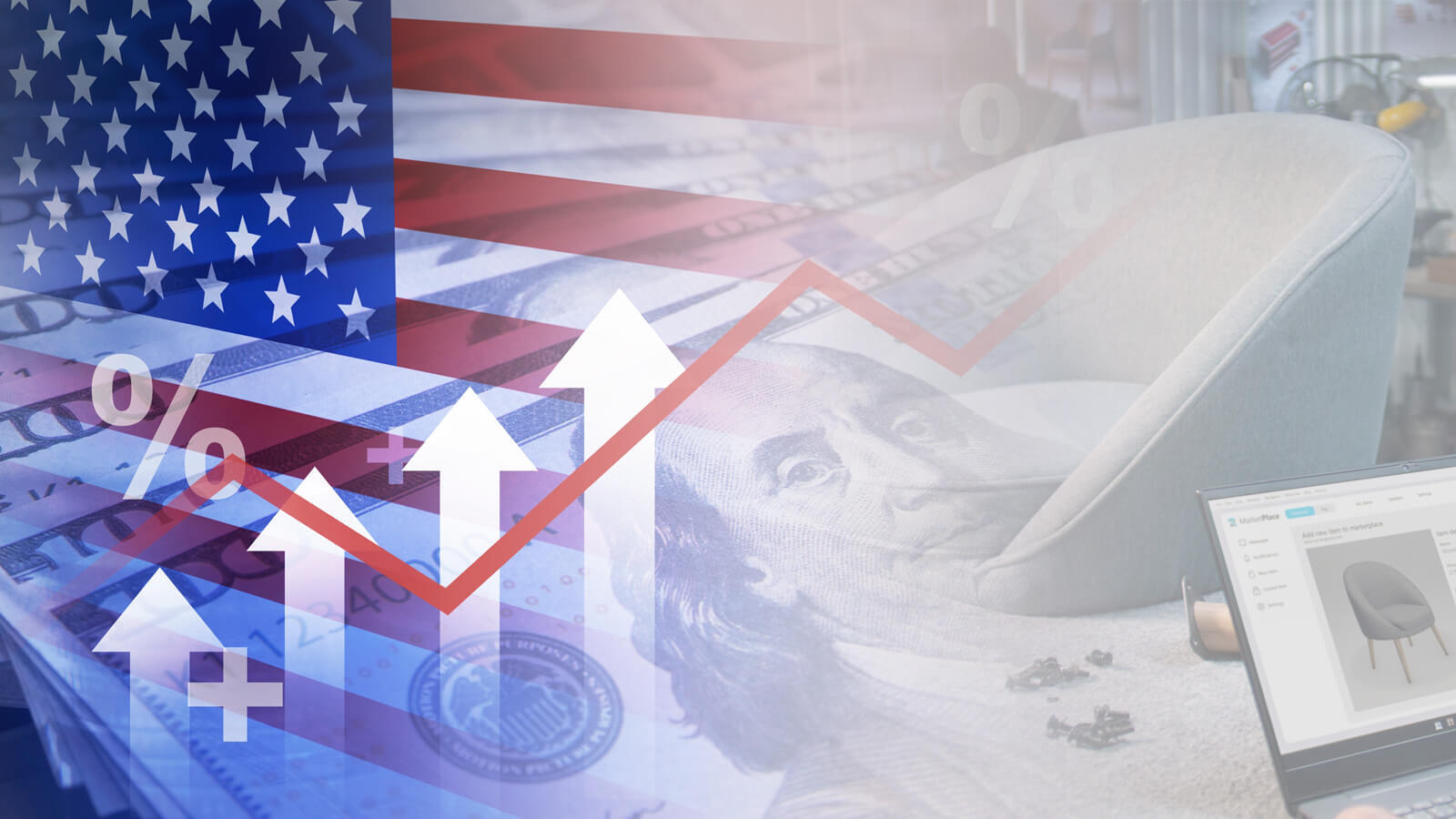As the topic of U.S. tariffs continues to reshape global trade dynamics, European furniture companies, though not directly targeted, are still likely to feel the ripple effects.
Summary:
-
Leverage trade agreements and regional sourcing: Use EU FTAs (e.g., EU-Japan, EU-Canada) and post-Brexit trade terms to reduce tariff costs. Consider diversifying sourcing to regions with lower tariffs like Eastern Europe, Turkey, and North Africa.
-
Adapt to EU regulations and consumer demands: Stay updated on EU tariff reforms and sustainability standards. Tailor products to regional preferences, such as eco-friendly options in Northern Europe and affordable styles in Southern Europe.
-
Invest in digital tools and e-commerce: Use 3D product visualization and AR to enhance the customer experience and optimize e-commerce platforms for cost-effective sales and smoother transactions.
From shifting supply chain flows to increased competition and pricing pressures, the impact will be hard to ignore. While these changes are U.S.-driven, the strategic response doesn’t have to be. By anticipating market shifts and adapting sourcing, pricing, and go-to-market strategies, European furniture businesses can stay competitive, and even find new opportunities in the disruption.
1. Leverage trade agreements and regional partnerships
-
EU trade agreements: European furniture manufacturers can benefit from several free trade agreements (FTAs), including the EU-Japan Economic Partnership Agreement, the EU-Canada Comprehensive Economic and Trade Agreement (CETA), and the EU-South Korea FTA. These agreements help reduce tariff barriers, making it more cost-effective for EMEA-based furniture companies to source materials and export products to key markets.
-
Post-Brexit trade agreements: Companies based in the UK or EU should stay up-to-date on the evolving terms of the UK-EU Trade and Cooperation Agreement, which impacts tariff treatment on goods traded between the two regions. With the UK leaving the EU, companies should optimize their supply chains to take full advantage of tariff exemptions under the agreement.
Key action steps for EMEA furniture companies
-
Review regional FTAs: Identify which agreements offer the best advantages for sourcing materials or selling to target markets (e.g., exporting to the U.S. from the EU or leveraging trade with Asia).
-
Focus on compliance: Ensure that products meet the regulatory requirements for duty-free treatment under FTAs. This includes Rules of Origin criteria, which determine the country of origin for tariff purposes.
2. Reassess sourcing and manufacturing locations
-
Diversification of sourcing: While countries like Vietnam, China, and India have been key suppliers, the current tariff landscape may make it more advantageous for EMEA-based furniture companies to diversify their supply chains. High tariffs on Vietnamese and Chinese imports (e.g., 46% on Vietnam) may push businesses to look for alternatives in Eastern Europe, Turkey, or North Africa, where tariffs are lower or non-existent under existing trade agreements.
-
Nearshoring: As the U.S. and EU have increased tariffs on goods from some Asian countries, nearshoring production to Eastern Europe or Turkey could offer cost savings while maintaining proximity to key European markets.
Key action steps for EMEA furniture companies
-
Seek alternative sourcing hubs: Identify suppliers in regions with lower tariffs or more stable trade relations with the EU and U.S. Consider countries in North Africa, such as Morocco or Tunisia, which have trade agreements with the EU.
-
Nearshore manufacturing: Evaluate the feasibility of nearshoring manufacturing within the EU or neighboring regions, especially for high-demand or customizable products, to reduce lead times and tariff exposure.
3. Focus on EU-specific tariffs and regulations
-
European tariff policies: The EU has a common external tariff on imports from outside the union. As of now, furniture goods from non-EU countries (e.g., China, Vietnam) are still subject to these tariffs, which can be up to 20% or higher depending on the product. However, the EU’s trade policies also provide opportunities for tariff reductions or exemptions on certain goods or under specific trade agreements (e.g., EU-Mercosur Agreement, EU-Canada CETA).
-
Environmental regulations: The EU is increasingly focusing on environmental sustainability with stricter regulations on materials, production processes, and waste management. Furniture companies will need to adapt their products and processes to meet these new standards, which may also impact the costs and marketability of certain items.
Key action steps for EMEA furniture companies
-
Monitor EU tariff reforms: Stay informed on any changes in EU tariffs, especially with new agreements like the EU-Mercosur trade agreement that may offer tariff-free access to South American markets.
-
Ensure compliance with sustainability standards: Evaluate and upgrade production methods to meet the EU’s Green Deal and Circular Economy guidelines, which are becoming more important in terms of market access and consumer demand.
4. Adapt to local market demands and economic conditions
-
Consumer behavior: In EMEA markets, consumer behavior can vary significantly. In regions like Germany and the UK, demand for high-quality, durable, and sustainable furniture is growing. Meanwhile, in Southern Europe or the Middle East, furniture buyers may prioritize affordability and style over sustainability.
-
Economic uncertainty: EMEA companies must also prepare for fluctuating exchange rates and potential economic instability in certain regions. Tariff increases and supply chain disruptions can exacerbate price pressures and affect profitability.
Key action steps for EMEA furniture companies
-
Conduct market research: Understand local consumer trends and tailor product offerings based on regional preferences (e.g., focus on eco-friendly materials in Northern Europe or low-cost, stylish options in Mediterranean markets).
-
Hedge against currency risk: Implement strategies such as currency hedging or localizing manufacturing to reduce exposure to exchange rate fluctuations between the euro, pound, and other currencies in the region.
5. Implement digital tools for efficiency and customer engagement
-
Digital transformation: With the increase in global tariffs, furniture companies in EMEA should leverage digital technologies such as 3D product visualization and augmented reality (AR) to improve product sales, especially as physical showroom traffic may decline. Digital solutions also enable companies to scale operations while controlling costs related to international shipping and inventory.
-
E-commerce and DTC: The shift to direct-to-consumer (DTC) models and e-commerce is strong in the EMEA region. Adapting to digital sales channels will help companies increase sales volumes without incurring the high costs associated with physical retail or global distribution.
Key action steps for EMEA furniture companies
-
Invest in AR and 3D product visualization: Enhance the customer experience with virtual try-on features, interactive product showcases, and realistic 3D visuals that can simulate real-world spaces.
-
Strengthen e-commerce platforms: Optimize online sales platforms to provide easy product customization, secure payment options, and effective communication channels, ensuring smooth transactions even during international supply chain disruptions.
Insights for Furniture Companies Based Outside the U.S.
For companies located in regions outside the U.S. (EMEA, Asia, Latin America), tariffs are an ongoing challenge but can be mitigated through strategic sourcing, production, and pricing adjustments:
-
Tariff impact on sourcing: The rising tariff burden on goods imported from China, Vietnam, and other Asian countries affects manufacturers in the U.S. and EMEA. As such, furniture companies should consider diversifying suppliers from countries with favorable trade agreements or lower tariffs, such as Turkey, Eastern Europe, or Mexico (for U.S.-based exports).
-
Regional trade policies: Furniture businesses in EMEA can leverage EU trade agreements to access preferential tariff treatment, reducing the cost burden. Likewise, Asian countries can use ASEAN agreements to reduce trade barriers and tariff costs for goods sold into the EU, U.S., and other regions.
-
Supply chain resilience: Consider adopting a hybrid supply chain model that combines local and global sourcing to reduce risks associated with high tariffs. This can also provide more flexibility in adapting to geopolitical shifts, such as Brexit or trade tensions in Asia.
Turning uncertainty into opportunity
For furniture companies based in EMEA and outside the U.S., the evolving tariff landscape requires agility and strategic thinking. Embracing digital tools, diversifying suppliers, leveraging trade agreements, and adapting to local consumer preferences are critical steps to overcoming challenges. By staying informed and adapting to regional dynamics, businesses can not only minimize the impact of tariffs but also position themselves for long-term growth in a competitive, unpredictable market.
At Cylindo, we’re proud to partner with some of the most forward-thinking furniture brands in the industry, helping them not just survive in an uncertain market, but thrive. Curious to find out more? Let’s talk.



